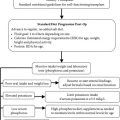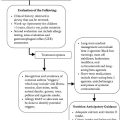10.1 Cancer
10.1.1 Name of Disorder
Cancer.
10.1.2 Nutritional Implications
Approximately 40–80% of children become malnourished during intensive cancer treatment. Malnutrition during chemotherapy is associated with increased infection rates, decreased tolerance of chemotherapy, delays in treatment, and diminished quality of life. Childhood cancers associated with the highest nutrition risk are presented in the table.
| Childhood Cancer | Factors Affecting Nutritional Status |
| Wilms tumor • High risk: Stage III and IV • Unfavorable histology • Relapsed disease | • Surgical resection of tumor and kidney • Post-operative ileus. • Radiation therapy: younger patients often nothing per mouth (NPO) several hours prior to treatment |
| Neuroblastoma • High risk: Stage III and IV • MYCN* amplification • Relapsed disease | • Young age (average age at diagnosis: 3.1 years) • Interruption in baseline feeding pattern • High need for enteral tube feeding • Postsurgery complications: High-output diarrhea • Hematopoietic stem cell transplantation (HSCT) • Prolonged transition after treatment back to 100% oral intake |
| Sarcomas • High risk: Stage III and IV • Rhabdomyosarcoma (RMS) (especially parameningeal RMS) • Ewing • Osteosarcoma • Metastatic disease | • Compressed chemotherapy cycles • Treatment with highly emetogenic and chemotherapy • Lack of recovery time between chemotherapy to regain lost weight • High energy and protein requirements |








